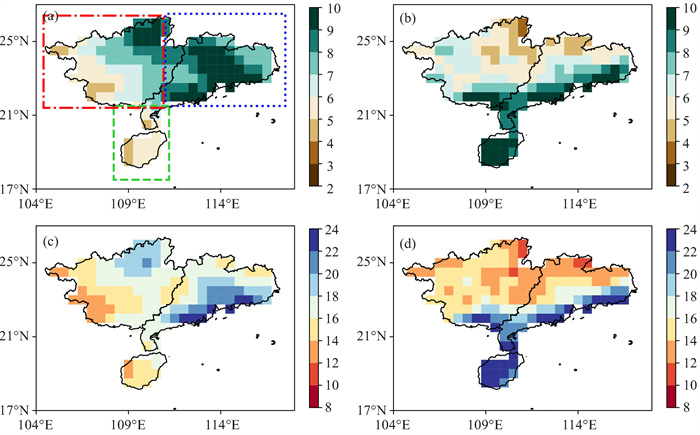Capability of Subseasonal-to-Seasonal Prediction Models in Forecasting Precipitation in South China During Rainy Seasons
-
摘要: 利用次季节-季节(S2S)预报计划多模式回报数据集和国家气象观测站逐日降水数据,通过确定性指标评估了CMA、ECMWF、NCEP、JMA、UKMO这5家S2S模式对华南前后汛期降水的预报技巧,并分析了不同类型降水事件的可预报性。各模式在表征降水强度与变率方面存在一定局限性,普遍高估(低估)华南西北部(东南部)降水强度,低估全区降水变率。在时间相关技巧方面,前后汛期大多模式可提前1~2候熟练预测(相关系数通过了0.05的显著性检验)大部分地区降水。根据平均方差技巧,模式可预报性较低,多数模式对大部分区域降水的熟练预报(平均方差技巧大于0)仅在第1候。ECMWF模式显示了最熟练、稳健的预报能力,基于时间相关与平均方差技巧所揭示的可预报性上限为2~3候。在短预报时效(1候)下,后汛期模式预报技巧较高于前汛期,但随预报时效的增加,模式预报能力较前汛期下降更迅速。在S2S时间尺度,降水异常事件通常具有比平均事件更高的可预报性。
-
关键词:
- 次季节-季节预报模式 /
- 华南 /
- 汛期 /
- 降水 /
- 预报技巧
Abstract: This study evaluated the deterministic skills of subseasonal-to-seasonal (S2S) prediction models, including the CMA, ECMWF, NCEP, JMA, and UKMO models, in predicting precipitation during the rainy seasons in South China. It analyzed the predictability of various types of precipitation events utilizing the S2S prediction multi-model reforecast dataset and daily precipitation data from national meteorological stations. The results revealed limitations in these models'ability to predict precipitation intensity and variability. Generally, these models tended to overestimate precipitation intensity in the northwestern part of South China while underestimating it in the southeastern part. Moreover, these models underestimated the overall precipitation variability in the region. In terms of temporal correlation, most models showed useful skills, with correlation coefficients statistically significant at the 95% confidence level, in predicting precipitation for most areas during the rainy seasons, with a lead time of 1-2 pentads. However, most of these models exhibited low predictability in accurately capturing the anomalous precipitation patterns (measured by mean square skill), and their useful forecast lead time (mean square skill > 0) was only 1 pentad for most regions. Among the models, ECMWF demonstrated the highest level of prediction capability, exhibiting strong and consistent performance as indicated by the temporal correlation and mean square skill, with a predictability upper limit of 2 to 3 pentads. For forecasts with a short lead time (1 pentad), these models exhibited higher prediction skills for the second rainy season. However, as the lead time increased, the models' skills declined more rapidly during the second rainy season. Anomalous precipitation events generally exhibited higher predictability than average events at the S2S timescale. -
图 3 同图 2,但为模式预报降水标准差差值
图 5 同图 4,但为后汛期预报降水距平TCC技巧
图 8 同图 7,但为后汛期预报降水距平MSSS空间分布
表 1 本研究所使用S2S模式历史回报数据介绍
模式 预报时效 回报类型 预报频率 回报时段 集合成员数 海洋耦合 海冰耦合 前汛期/后汛期起报样本量 ECMWF 0~46 d 动态 2 times·wk-1 2000—2019年 11 是 否 520/520 CMA 0~60 d 动态 2 times·wk-1 2005—2019年 4 是 是 390/390 NCEP 0~44 d 固定 1 time·d-1 1999—2010年 4 是 是 1 092/1 104 JMA 0~33 d 固定 3 times·mo-1 1981—2010年 5 否 否 180/180 UKMO 0~60 d 动态 4 times·mo-1 1993—2016年 3 是 是 288/288 -
[1] 梁建茵, 吴尚森. 广东省汛期旱涝成因和前期影响因子探讨[J]. 热带气象学报, 2001, 17(2): 97-108. [2] 王志伟, 唐红玉, 李芬. 近50年中国华南雨涝变化特征分析[J]. 热带气象学报, 2005, 21(1): 87-92. [3] 蔡悦幸, 陆希, 杨崧. 华南地区前后汛期极端降水事件对比分析[J]. 中山大学学报(自然科学版), 2018, 57(1): 83-92. [4] 伍红雨, 杨崧, 蒋兴文. 华南前汛期开始日期异常与大气环流和海温变化的关系[J]. 气象学报, 2015, 73(2): 319-330. [5] 吴尚森, 黄成昌, 薛惠娴. 华南后汛期降水的年际变化[J]. 热带气象, 1990, 6(4): 348-356. [6] 陆虹, 陈思蓉, 郭媛, 等, 近50年华南地区极端强降水频次的时空变化特征[J]. 热带气象学报, 2012, 28(2): 219-227. [7] LI C H, LI T, GU D J, et al. Relationship between summer rainfall anomalies and sub-seasonal oscillations in South China[J]. Climate Dyn, 2015, 44(1-2): 423-439. [8] 薛亮, 袁淑杰, 王劲松. 我国不同区域气象干旱成因研究进展与展望[J]. 干旱气象, 2023, 41(1): 1-13. [9] 齐庆华. 中国东部降水的极端特性及其气候特征分析[J]. 热带气象学报, 2019, 35(6): 742-755. [10] XIE J H, HSU P C, HU Y M, et al. Disastrous persistent extreme rainfall events of the 2022 pre-flood season in South China: Causes and subseasonal predictions[J]. J Meteor Res, 2023, 37(4): 469-485. [11] VITART F, COAUTHORS. The subseasonal to seasonal (S2S) prediction project database[J]. Bull Amer Meteor Soc, 2017, 98(1): 163-173. [12] ZHANG C. Madden-Julian oscillation[J]. Rev Geophys, 2005, 43: RG2003. [13] ZHANG C. Madden-Julian oscillation: bridging weather and climate[J]. Bull Amer Meteor Soc, 2013, 94(12): 1 849-1 870. [14] HSU P C, LEE J Y, KYUNG J. Influence of boreal summer intraseasonal oscillation on rainfall extremes in southern China[J]. Int J Climatol, 2016, 36(3): 1 403-1 412. [15] GAO Y, HSU P C, CHE S, et al. Origins of intraseasonal precipitation variability over North China in the Rainy Season[J]. J Climate, 2022, 35(18): 6 219-6 236. [16] ZHOU F, FANG Y H, SHI J, et al. Modulation of mid-high-latitude intraseasonal variability on the occurrence frequency of Northeast China cold vortex in early summer[J]. J Climate, 2023, 36(12): 4 235-4 253. [17] 袁媛, 李崇银, 凌健. 不同分布型El Niño期间MJO活动的差异[J]. 中国科学: 地球科学, 2015, 45(3): 318-334. [18] FORD T W, DIRMEYER P A, BENSON D O. Evaluation of heat wave forecasts seamlessly across subseasonal timescales[J]. NPJ Clim Atmos Sci, 2018, 1(1): 20. [19] XIE J H, YU J H, CHEN H S, et al. Sources of subseasonal prediction skill for heatwaves over the Yangtze River basin revealed from three S2S models[J]. Adv Atmos Sci, 2020, 37(12): 1 435-1 450. [20] TIAN B J, WALISER D E, KAHN R A, et al. Modulation of Atlantic aerosols by the madden-Julian oscillation[J]. J Geophy Res: Atmosphere, 2011, 116 (D15): D15108. [21] STOCKER T F, QIN D, PLATTNER G K, et al. Contribution of working group I to the fifth assessment report of the intergovernmental panel on climate change[R]//IPCC. Climate change 2013: the physical science basis. Cambridge, United Kingdom and New York, USA: Cambridge University Press, 2013: 1 535. [22] DE ANDRADE F M, COELHO C A S, CAVALCANTI I F A. Global precipitation hindcast quality assessment of the Subseasonal to Seasonal (S2S) prediction project models[J]. Climate Dyn, 2019, 52(9-10): 5 451-5 475. [23] LIANG P, LIN H. Sub-seasonal prediction over East Asia during boreal summer using the ECCC monthly forecasting system[J]. Climate Dyn, 2018, 50(3-4): 1 007-1 022. [24] LIU B Q, YAN Y H, ZHU C W, et al. Record-breaking Meiyu rainfall around the Yangtze River in 2020 regulated by the subseasonal phase transition of the North Atlantic Oscillation[J]. Geophys Res Lett, 2020, 47(22): e2020GL090342. [25] XIE J H, HSU P C, HU Y M, et al. Disastrous persistent extreme rainfall events of the 2022 pre-flood season in South China: Causes and Subseasonal predictions[J]. J Meteor Res, 2023, 37(4): 469-485. [26] VITART F, ROBERTSON A W. The sub-seasonal to seasonal prediction project (S2S) and the prediction of extreme events[J]. NPJ Clim Atmos Sci, 2018, 1(1): 3. [27] QUESADA B, VAUTARD R, YIOU P, et al. Asymmetric European summer heat predictability from wet and dry southern winters and springs[J]. Nat Clim Change, 2012, 2(10): 736-741. [28] WULFF C O, DOMEISEN D I V. Higher subseasonal predictability of extreme hot European summer temperatures as compared to average summers[J]. Geophys Res Lett, 2019, 46(20): 11 520-11 529. [29] BRETHERTON C S, WIDMANN M, DYMNIKOV V P, et al. The effective number of spatial degrees of freedom of a time-varying field[J]. J Climate, 1999, 12(7): 1 990-2 009. -






 下载:
下载:











 粤公网安备 4401069904700003号
粤公网安备 4401069904700003号